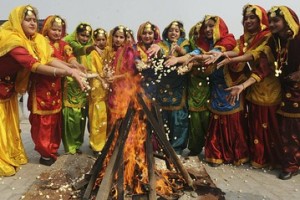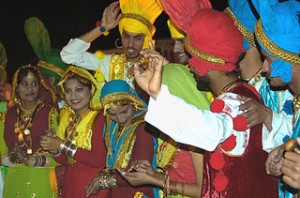Lohri: The bonfire festival of Punjab
 Celebrated with the full swing of happiness and revelry in the states of Northern India, especially Punjab, Haryana and Himachal Pradesh, Lohri is considered as the opening festival of every year celebrated on 13 January in India. Celebrated on winter solstice, just a day before of Makar Sankranti, Lohri is believed to be celebrated on winter solstice, being the shortest day and the longest night of the year.
Celebrated with the full swing of happiness and revelry in the states of Northern India, especially Punjab, Haryana and Himachal Pradesh, Lohri is considered as the opening festival of every year celebrated on 13 January in India. Celebrated on winter solstice, just a day before of Makar Sankranti, Lohri is believed to be celebrated on winter solstice, being the shortest day and the longest night of the year.
There are many origins of Lohri: all forming part of folklore. However, the main theme of Lohri is the belief that Lohri is the cultural celebration of the winter solstice. Lohri is meant to be celebrated on the shortest day of the year. A key feature of Lohri is the bonfire. Lighting of the fire has been common in winter solstice festivals throughout time and the world: it signifies the return of longer days. The bonfire is an ancient tradition, forming a key part of Lohri traditions.
Significances:
In Punjab, wheat is the main winter crop, which is sown in October and harvested in March or April. In January, the fields come up with the promise of a golden harvest, and farmers celebrate Lohri during this rest period before the cutting and gathering of crops.
It holds a special significance to the folks of Punjab. They keep busy in making preparations for Lohri. They come out of their homes and celebrate the harvesting of the Rabi (winter) crops and give in to relaxing and enjoying the traditional folk songs and dances. A few days before the festival, the children tend to assemble woods and eatables like peanuts, nuts, til (sesame) seeds, or sweets like jaggery, gajak, rewri, etc.
Mythologies
 It is considered that a Punbaji dacoit named Dulla Bhatti who used to rob the rich to help the poor had once helped two miserable village girls “Sundari” and “Mundari” by getting them married off like his own daughters. In the trouble moment, he helped the girls by convincing the grooms and their families to marry the girls in a forest and presented them sugar in form of ritual.
It is considered that a Punbaji dacoit named Dulla Bhatti who used to rob the rich to help the poor had once helped two miserable village girls “Sundari” and “Mundari” by getting them married off like his own daughters. In the trouble moment, he helped the girls by convincing the grooms and their families to marry the girls in a forest and presented them sugar in form of ritual.
Song & Dance
Bhangra dance by men begins after the offering to the bonfire. Dancing continues till late night with new groups joining in amid the beat of drums. Traditionally, women do not join Bhangra. They hold a separate bonfire in their courtyard orbiting it with the graceful gidda dance.
A Celebration of Fertility
Lohri brings fertility and the joy of life, and in the event of the birth of a male child or a marriage in the family, it assumes a larger significance wherein the host family arranges for a feast and merry-making with the traditional bhangra dance along with rhythm instruments, like the dhol and the gidda. The first Lohri of a new bride or a newborn baby is considered extremely important.
Thanksgiving & Get-together!
Nowadays, Lohri brings in an opportunity for people in the community to take a break from their busy schedule and get together to share each other’s company. In other parts of India, Lohri almost coincides with the festivals of Pongal, Makar Sankranti, and Uttarayan all of which communicate the same message of oneness and celebrates the spirit of brotherhood, while thanking the Almighty for a bountiful life on earth.



Woah! I’m really diggin the template/theme of this website.
It’s simple, yet effective. A lot of times it’s very difficult to get that “perfect balance” between user friendliness and appearance.
I must say that you’ve done a superb job with this. In addition, the blog
loads super quick for me on Firefox. Exceptional Blog!
A big thank you for your applauses. Readers like you make every post powerful
We’ll keep posting such informative and interesting posts. Have a great day.